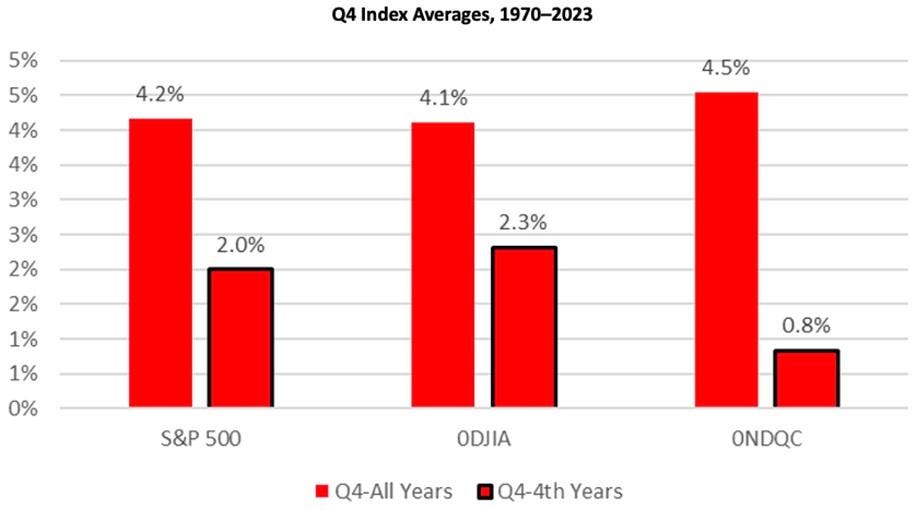After a strong three quarters of a year, U.S. equity markets enter the final quarter with strong gains across the board. Normally, the stocks have their best performance in the November to April period. In fact, looking back, in the period from 1970 to present, the stock market averaged an above 4% return in the fourth quarter of the year. However, 2024 is an election year, and while still positive, the returns in election years have been muted with the S&P 500 returning 2% as shown in Figure 1. This is greatly below a typical year where returns average over 4% in the fourth quarter.
Figure 1: Index Averages in Q4 of Election Year
Within the fourth quarter, October tends to be the problem month with a negative return for all three of the major indexes. Typically, this is followed by a recovery in November and December once the election passes. As a whole, the Nasdaq has a tendency to lag the S&P 500 and DJIA in the fourth quarter of election years. This is shown below in Figure 2.
Figure 2: Monthly Index Averages in Q4 of Election Year
Looking at each year since 1970, the monthly performance varies as seen in the three tables below. October is negative six of 13 times on the S&P 500, eight of 13 on the DJIA, and 10 of 13 on the Nasdaq. November is negative five, six, and four times on the respective indices. December is also negative five, six, and four times on the respective indices.
Figures 3, 4, 5: Monthly Index Performance in Q4 of Election Year
In terms of sector performance during the fourth quarter of an election year, more cyclical groups tend to be favored with Transportation, Capital Equipment and Basic Materials doing best. Interestingly, the defensive sector, Utility, also does well. It appears investors enter the next term of the presidential cycle more optimistic on the economy. Conversely, Technology, which enjoys substantial outperformance in the third year of the cycle and the first half of the fourth year, tends to lag just before the election, as seen in Figure 6.
Figure 6: Sector Averages in Q4 of Election Year
Currently, the sector setup is favorable for several of the historical Q4 leaders including Capital Equipment and Utility, but less so for Energy and Transportation. These could create strong opportunities in the two latter sectors if history holds. Also, looking forward a bit further, once through October, the market moves into the much more historically favorable November through April period for performance.
Figure 7: Index Averages May-October and November-April
Into Q4 2024, the market internals are very strong, so it will be interesting to see if this October can buck its normal trend and be strong. William O’Neil + Co. studies the number of stocks breaking out each week. We define a breakout as a stock breaking above prior highs after a minimum period of five weeks of consolidation. Recent weekly breakout totals have continued to spike every few weeks, which is normally indicative of an ongoing bull market as shown in Figures 8 and 9.
Figures 8, 9: U.S. Weekly Stock Breakouts
Excluding the ever-increasing ETF effect, the breakout totals in Figure 8, excluding the Financial sector (which houses all ETFs), are also strong, although somewhat below two prior bull markets in 2020–2021 and 2017–2018. This is usually a sign that the stock market will continue to rise from its existing levels.
Themes where there is strong breadth in terms of stocks breaking out of bases recently include Homebuilders (XHB), Utilities (XLU), REITs/Real Estate (IYR), Midcap Software (SKYY), Online Retail (IBUY), Payments (IPAY), Infrastructure (PAVE), Leisure and Entertainment (PEJ), Insurance (IAK), and Emerging Markets (EEM). Below are the respective Datagraphs® with the ETF for each industry group.
Figures 10, 11, 12: Leading Themes/Groups
In conclusion, given its recent run, the U.S. stock market may be due for a pullback in October if normal election year seasonality holds. However, we will prefer to buy if this weakness occurs given the historical strength stocks experience after the election and after the Fed starts cutting rates. We discussed this last point in our August article. So, investors should be ready to increase equity exposure as we enter the best period of the year.
Kenley Scott, Director, Global Sector Strategist at William O’Neil + Co., made significant contributions to the data compilation, analysis, and writing for this article.
Disclosures
No part of the authors’ compensation was, is, or will be directly or indirectly related to the specific recommendations or views expressed herein. William O’Neil + Co., its affiliates, and/or their respective officers, directors, or employees may have interests, or long or short positions, and may at any time make purchases or sales as a principal or agent of the securities referred to herein.
William O’Neil + Co. Incorporated is an SEC Registered Investment Adviser. Employees of William O’Neil + Company and its affiliates may now or in the future have positions in securities mentioned in this communication. Our content should not be relied upon as the sole factor in determining whether to buy, sell, or hold a stock. For important information about reports, our business, and legal notices please go to www.williamoneil.com/legal.
© 2024, William O’Neil + Company, Inc. All Rights Reserved.
No part of this material may be copied or duplicated in any form by any means or redistributed without the prior written consent of William O’Neil + Co.
Read the full article here

